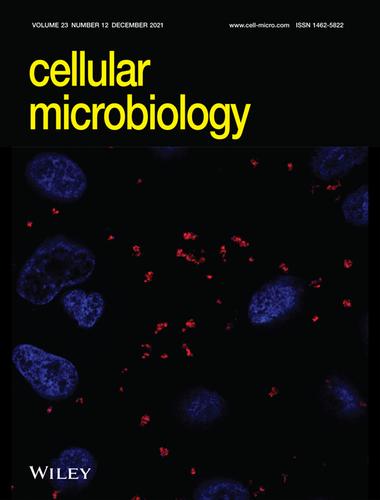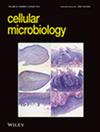Cover Image: Entry of the Varicellovirus Canid herpesvirus 1 into Madin–Darby canine kidney epithelial cells is pH-independent and occurs via a macropinocytosis-like mechanism but without increase in fluid uptake (Cellular Microbiology 12/2021)
IF 1.6
2区 生物学
Q3 CELL BIOLOGY
引用次数: 0
Abstract
Confocal micrograph showing Canid herpesvirus 1 (red) bound to MDCK cells, and DAPI-stained nuclei (blue). Primary amines of viral glycoproteins were labelled with Alexa Fluor succinimidyl esters 568 dye. For further details, readers are referred to the article by Eisa et al. on p. e13398 of this issue.

封面图片:犬疱疹病毒1型进入Madin-Darby犬肾上皮细胞是pH无关的,通过大细胞吞噬作用样机制发生,但不会增加液体摄取(细胞微生物学,2021年12月)
共聚焦显微照片显示犬疱疹病毒1(红色)与MDCK细胞结合,dapi染色的细胞核(蓝色)。用Alexa氟琥珀酰亚胺酯568染料标记病毒糖蛋白的伯胺。欲了解更多细节,请参阅Eisa等人在本期e13398页上的文章。
本文章由计算机程序翻译,如有差异,请以英文原文为准。
求助全文
约1分钟内获得全文
求助全文
来源期刊

Cellular Microbiology
生物-微生物学
CiteScore
9.70
自引率
0.00%
发文量
26
审稿时长
3 months
期刊介绍:
Cellular Microbiology aims to publish outstanding contributions to the understanding of interactions between microbes, prokaryotes and eukaryotes, and their host in the context of pathogenic or mutualistic relationships, including co-infections and microbiota. We welcome studies on single cells, animals and plants, and encourage the use of model hosts and organoid cultures. Submission on cell and molecular biological aspects of microbes, such as their intracellular organization or the establishment and maintenance of their architecture in relation to virulence and pathogenicity are also encouraged. Contributions must provide mechanistic insights supported by quantitative data obtained through imaging, cellular, biochemical, structural or genetic approaches.
 求助内容:
求助内容: 应助结果提醒方式:
应助结果提醒方式:


